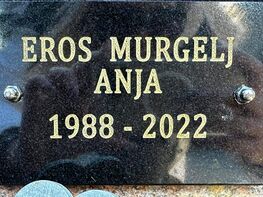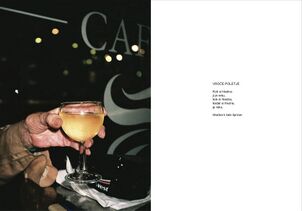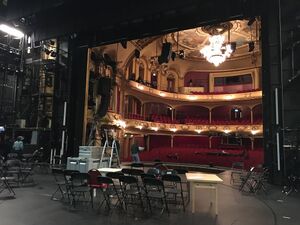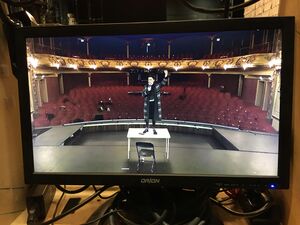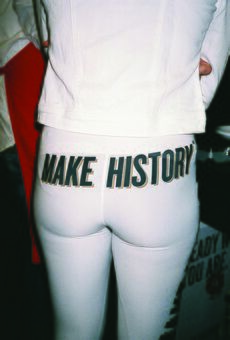Nina: Difference between revisions
No edit summary |
No edit summary |
||
| (4 intermediate revisions by the same user not shown) | |||
| Line 1: | Line 1: | ||
'''TEXT''' | |||
'''TEXT''' | |||
''My Body is Just a Shell'' is a 5<nowiki>'3'' long film I made with two intersex people I met in Slovenia in 2021. With this video I want to show two different stories of two people who had a very similar starting point as children but lived very different lives because of their parents' decision. At the age of one, Eros's parents allowed him to be operated on by doctors to become a woman, which caused him a lot of health problems, but also a lot of psychological pain, because he felt more male than female, and he never understood where this desire came from. His parents never told him that he was an intersex person, he realised this at the age of 23 through meditation. His parents never accepted him as a man, calling him Anja until the end. Luke's mother educated herself on the subject and their rights and refused to allow the doctors to operate on him. Luka'</nowiki>s family accepted him for who he is. | ''My Body is Just a Shell'' is a 5<nowiki>'3'' long film I made with two intersex people I met in Slovenia in 2021. With this video I want to show two different stories of two people who had a very similar starting point as children but lived very different lives because of their parents' decision. At the age of one, Eros's parents allowed him to be operated on by doctors to become a woman, which caused him a lot of health problems, but also a lot of psychological pain, because he felt more male than female, and he never understood where this desire came from. His parents never told him that he was an intersex person, he realised this at the age of 23 through meditation. His parents never accepted him as a man, calling him Anja until the end. Luke's mother educated herself on the subject and their rights and refused to allow the doctors to operate on him. Luka'</nowiki>s family accepted him for who he is. | ||
| Line 45: | Line 43: | ||
I have a lot of ideas that I want to work on, one of them is how to experience nature in virtual reality combined with smell, to test how we could experience nature in spaces that are alienated from the natural environment or destroyed in the future. I also want to explore more dreams and out-of-body experiences. There was an interesting reference by Chiad about Sufism and dreams, which I want to explore more. I am also interested in the International Court of Justice, which is based in The Hague, its subjects and the impact. I read recently that in 2002 George Bush signed the 'Hague Invasion Act', which became law. A year ago, I watched the documentary Iraq, the Destruction of a Nation, a French documentary from 2020, directed by Jean-Pierre Canet, which changed my view of the media and politics, their abuse of power and manipulation of information. | I have a lot of ideas that I want to work on, one of them is how to experience nature in virtual reality combined with smell, to test how we could experience nature in spaces that are alienated from the natural environment or destroyed in the future. I also want to explore more dreams and out-of-body experiences. There was an interesting reference by Chiad about Sufism and dreams, which I want to explore more. I am also interested in the International Court of Justice, which is based in The Hague, its subjects and the impact. I read recently that in 2002 George Bush signed the 'Hague Invasion Act', which became law. A year ago, I watched the documentary Iraq, the Destruction of a Nation, a French documentary from 2020, directed by Jean-Pierre Canet, which changed my view of the media and politics, their abuse of power and manipulation of information. | ||
In general, I want to allow myself to create more freely, to be more experimental, to explore different media, not only video and sound, but maybe other media that I haven't worked with before, such as touch, emotion, smell, large-scale installations, performance, artificial intelligence, digital space, etc. I want to separate myself from titles like visual artist, scenographer, architect. I want to (re)search more, experiment more, create more, enjoy more, travel more, research more, interview more, meet more people, see more of the world, maybe the moon, maybe the universe. With the speed of technology, it seems to me that anything is now possible. So, let's go? | In general, I want to allow myself to create more freely, to be more experimental, to explore different media, not only video and sound, but maybe other media that I haven't worked with before, such as touch, emotion, smell, large-scale installations, performance, artificial intelligence, digital space, etc. I want to separate myself from titles like visual artist, scenographer, architect. I want to (re)search more, experiment more, create more, enjoy more, travel more, research more, interview more, meet more people, see more of the world, maybe the moon, maybe the universe. With the speed of technology, it seems to me that anything is now possible. So, let's go? | ||
Sources: | Sources: | ||
Bjørnson, B. M. (2003). Beyond Our Power: Over Evne. Fredonia Books. | Bjørnson, B. M. (2003). Beyond Our Power: Over Evne. Fredonia Books. | ||
Barker, N. (February 1st 2023). "An architect who only designs buildings is like a doctor who only prescribes paracetamol" says ProxyAddress founder. Dezeen. Online source, from: https://www.dezeen.com/2023/02/01/proxyaddress-chris-hildrey-interview/?fbclid=IwAR0Fii3AzAxVXVK9jkE_J9ERRSeeXGPE4B02Pw1bWZBkAvSouVVLsBC0G44# | Barker, N. (February 1st 2023). "An architect who only designs buildings is like a doctor who only prescribes paracetamol" says ProxyAddress founder. Dezeen. Online source, from: https://www.dezeen.com/2023/02/01/proxyaddress-chris-hildrey-interview/?fbclid=IwAR0Fii3AzAxVXVK9jkE_J9ERRSeeXGPE4B02Pw1bWZBkAvSouVVLsBC0G44# | ||
[[File:36small.jpg|thumb|Cover photo of poezin Pesmi z Bavarca, I took this photo at a party in Ljubljana, 2016|340x340px|left]] | |||
[[File:Screenshot 2023-03-30 at 07.32.49.png|thumb|Ieva washing hands|645x645px|left]] | |||
Latest revision as of 15:10, 30 March 2023
TEXT
My Body is Just a Shell is a 5'3'' long film I made with two intersex people I met in Slovenia in 2021. With this video I want to show two different stories of two people who had a very similar starting point as children but lived very different lives because of their parents' decision. At the age of one, Eros's parents allowed him to be operated on by doctors to become a woman, which caused him a lot of health problems, but also a lot of psychological pain, because he felt more male than female, and he never understood where this desire came from. His parents never told him that he was an intersex person, he realised this at the age of 23 through meditation. His parents never accepted him as a man, calling him Anja until the end. Luke's mother educated herself on the subject and their rights and refused to allow the doctors to operate on him. Luka's family accepted him for who he is.
I started to work on this project because in 2021, a friend recommended that I read the Instagram account of a doctor who gives all kinds of health advice for women, mainly on body care and healthy food. But in one of her posts she wrote 'my dad was operating on intersex babies' which shocked me, because I didn't know these operations were performed. I started researching about intersex people in Slovenia, but there was no information, except for online interviews with Anja Murgelj, who I later found out had changed her name to Eros Murgelj. I tried to contact him and finally succeeded through a photographer from one of the interviews. I met Eros for the first time in February 2022, Luka and Eros met in the end of March, and then I met each of them a few more times before we all met together in summer. Before their first meeting, I asked Eros to record their conversation with his phone, because I was interested in their conversation, but I didn't think I will ever use it in a project. The voice recording turned out to be an hour-long conversation in which they talked very openly and honestly about their life experiences, as they are both intersex. They allowed me to use them and I wanted their voice recordings to be the focal point of this film. The video starts with no picture, just sound. You can hear birds singing in the background, which is subtle but at the same time very important for the mood of the film. The voice-overs were recorded in nature, as Eros always suggested meeting in nature. He always said that it was only in nature that he really felt accepted, and the second title I had in mind for the film was Nature heals.
The video may seem linear and simple, but I wanted to make it in a way that really emphasised the narrative, which is quite dense and heavy and probably difficult for the viewer to take in in those five minutes. The narrative has a crescendo that builds up to the end when I use visual elements to show the faces of both of them, which further emphasises the message of the video. I very intuitively edited the first draft of this film the day before the first lesson at PZI with Barend, who later encouraged me to leave it that way. My first edit was actually very similar to the final film. I took some of the voice-overs that introduced the story and added video clips of parts of Eros' body. Luka didn't want to be filmed because he only revealed that he was intersex to the closest people in his life, because in Slovenia he was often laughed at if he said it. He writes poetry and likes to participate in art projects, so he allowed this film to be screened at Eye. I showed their faces only at the end of the video, which might come as a surprise, because their voice could be male or female, it is hard to define their gender only from sound. I latter added another two minutes of conversation and left the part in the end where we all speak and they laugh together, because I was able to have 5 minutes instead of 4 minutes, which was the limit for Eye. I hope that this structure evokes emotions and creates a strong mood in the video so that the audience can embrace their stories. Both the happiness of living the life of a person who can understand other beings more openly, live more freely, see beyond social constructs, and at the same time the deep sadness of being rejected for who you are, in Eros' case by his family.
In October 2022, I started thinking that I could make a short video for Eye from existing videos and footage I had from the summer. I combined my video footage that I shot with Eros and Luka and their voice recordings that they made when they first met. I worked with the material I already had, as I couldn't go to Slovenia to shoot more at the time, but I can't do that now because Eros has passed away, so these are the only recordings I have made with him. It's interesting how precious a recording of a person becomes the moment they are no longer physically present on Earth, how much visual or sound recordings become a doorway into a memory that would otherwise probably slowly fade away.
Listening to Eros talk about his story, I was stunned. He said that he was giving interviews to get the word out, but if you didn't search on the subject, you wouldn't come across it, because no one in Slovenia is talking about it. So how do we approach this so that we can change attitudes towards intersex people in the public and in the medical profession? How do we get his story into the public domain and how do we work with him to change things, because he wanted to change things for other intersex children so that they do not have to go through what he went through? Not only the psychological problems, but also the health problems and complications caused by the operation. Should we organise an intersex association? How should we find other intersex people, since they are registered as women and men? Should we present his body, which has become something else that it would have been without medical intervention? How do we not objectify the body? How to question or challenge a medical practice that is clearly outdated?
When I starterd the process of making this video about Eros and Luka, I felt that I would be able to tell their story in a gentle and subtle way. A few weeks after I have fineshed it, Luka called me in December and told me that Eros had died. It is difficult for me to write this text because I could not say goodbye to Eros. He died unexpectedly and suddenly. He died because his body collapsed, because he stopped taking his adrenal hormones, which also affected his hormones, so that he looked more like a female, for which doctors claimed him to be as a baby and operated on him. I never saw this film is a project, but more as more part of a mission. I did the film, but more as an introduction for people to start thinking about this topic than making an artistic document. These are real people, not some fantasy, imaginary world, or some thoughts I had in my dreams. I find it hard to imagine that people have to suffer all their lives just because they could not consider themselves as a man or a woman, which the system forced them to choose between.
I wanted to work with Eros to make this issue more visible in Slovenia and to ban the operations completely. He is gone, but I want to continue. He is gone now, but I want to continue. I am going to spend the summer in Slovenia and I am going to interview people who were close to him, with Luka's mother and their family. I would like to meet with the Minister for Health and Minister of Law, to talk about changing the law and enablig the medical profession to carry on these opereations. I want the Republic of Slovenia to ban the unnecessary operations, because the operations on intersex are just cosmetic operations, they are not necessary. I am in touch with NGO Pride Parade Association in Slovenia and would like to invite more people to collaborate in the process, with their knowledge and thier support in all ways possible. I want broad public to know this is still happening. I would like public to embrace intersaxual people as they are.
I am currently researching how this transition has worked in Germany and the Netherlands, where surgery on intersex children is already banned and they can make their own choice when they turn 18. I am also looking into how the legal documents are regulated in which it is necessary to determine one's gender. I had never thought about making a documentary, but Barednt asked me and I am now thinking about this idea. I would like to film these meetings as material for it. Next year I would like to continue working on this project and I maybe applying to the IDFA Development and production of a documentary workshop or something else.
Since I was a teenager, I have always been interested in marginalised groups, people who are perceived by society as strange, unusual, unusual, people who do not adapt to so-called reality, rebellious. I have been very interested in the knowledge and ways of living and connecting with the world of indigenous people, witchcraft, people with the ability to communicate beyond words. I was also interested in the psyche of people, fears such as fear of death, unknown, mystery, anxiety, mental hospitals, stigmas, systems of any kind, education. In what people give up for their comfort, how people are hypnotised by the comforts of everyday life, stereotypes, social rules, social expectations, how the West is moving away from nature. What are other ways of coexisting, systems that include all living organisms and forms, not just the rights of humans, animals and plants. I am interested in the structure of power, how the value of money has changed over the centuries, jobs as new systems of slavery, different aspects of (in)justice, how to invite change, freedom. I am interested in art as a form of change, but also as a space that embraces diversity and provides a space for open conversations. What are the ways to change things, where does the power of change come from, can it be done by one person or by a mass of people. ...
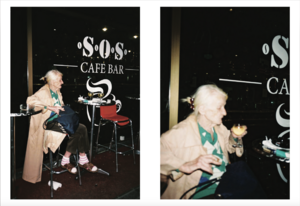
I have dealt with the subject of marginalised groups and places before. In 2014 I made Poezin, a book of poems and photographs that I wrote and took when I lived in Bavarski dvor, a part of Ljubljana near the train station where there were many homeless people. I had a room with a balcony facing the square, located among the high residential modernist blocks. Mostly concrete, only a few without, the echo was so loud that I could hear people talking on my balcony on the 9th floor. The poems are fictional, inspired by events and conversations in and around this square. I met, talked and drank with some of the people I photographed and listened to their stories. Now the area has changed, two new luxury hotels have been built in the last five years, so this poem is also a document of the changes and gentrification of the area. This work was exhibited at the Photon Gallery and is part of the permanent collection of P74, but at the time I wondered what a work of art can change when it is exhibited in a gallery or museum? The museum as a power structure. What are the other ways of exhibiting? This is something I'm interested in and something I'd like to explore more. I recently found out about ProxyAddress, a project founded by architect Chris Hildrey. He says that architects have a duty to use their knowledge to help solve social problems, even if that means thinking beyond designing buildings. After graduating from the Faculty of Architecture in Ljubljana, I wanted to work on such projects, but there is little financial and public support for such projects in Slovenia. I am now researching whether this already exists in the Netehrlands.
Another project that has had a strong influence on me is the theatre play Beyond our Power by Bjørnstjerne Martinius Bjørnson, Norway's first Nobel Prize laureate. In 2021, Slovenian theatre director Tomi Janežič was invited to perform the play at the National thatre in Oslo, Norway. I became part of the team as assistant to the set designer Branko Hojnik. We had already started working on the play, analysing the texts and coming up with set design ideas a year before. When we were in the middle of rehearsals in Oslo, the show was postponed due to the situation in Covid. The text is still incredibly accurate today, it's about men in power who are extracting from the land and exploiting the people who actually live in the village. The villagers, who are also workers, are fed up with their exploitation and toxic power relations. At one point, when all these men in power gather in a castle on a hill, one of the villagers commits suicide with a bomb, killing them all, and only one survives. This act raises many questions, from how to bring about change from the bottom up, about workers' rights, etc. Is it justifiable to kill twenty people in order to give thousands a better life, is it an act of courage or an act of desperation? Where does greed come from? I was recently very impressed by the documentary 'All the Beauty and the Bloodshed' about Nan Goldin. It shows her life's work, how her photographic work has changed and influenced the lives of many, the struggle of homosexuals with AIDS, her life and her recent protests against the Sackler family. Having a theatre background, I have also been influenced by Christoph Schlingensief, especially his Ausländer raus! project, and Milo Rau. I saw his film The New Gospel at the Venice Film Festival in 2020. It explores the complex interrelationships between a neo-colonial economic system, its constant access to goods and low prices, and the (economically poor) nations that are forced to provide for this demand. I am also very inspired by the artworks of Tadej Pogačar, Mladen Stilinović, Joseph Beuys, Warner Herzog, Ulrich Seidl, Susan Meiselas, Sinéad O'Connor, Svetlana Makarović, etc.
What can property in private hands mean but slavery to all the rest.'' No, indeed—property for nobody, and poverty for all: that's the ideal! [Tremendous outburst of approval] Freedom cannot exist side by side with the power of money. Poverty and freedom : there's the ideal for you ! [Applause as before]
Speech of the industrials, from the book Boyond our power by Byornson
After these busy winter months at school, I am slowly able to reflect on how much I have learned and what has been opened up for me at the PZI. For Res's seminar I did my first editing, for Chihad I also did a project, but I am stil exploring the ways to realise the idea, because the edit is more complex. He invited many interesting lecturers to show their films and have conversations with us. With Laura I am having an acces to films of indeginous people that I didn't have before. I am now also exploring the ways of how indeginous people embrace bodies of intersex people. Until now I have mostly worked with analogue film, so Esther's workshop was a great insight into how to work with analogue cinema and all the possibilities for experimentation that it allows. My boyfriend and I are planning now to make a music video shot with ARRI SR2 on 16 mm film for a Slovenian singer. Esther has also given us the contact details of an analogue film developer in Belgium, with whom we are already in contact. As I also want to create more experimental, abstract works, Sabina's workshop allowed me to experiment with found footage. She invited us to use footage from the Open Beelden archive, and as I don't understand Dutch, I started working with sound and voices only, which was new for me as my work is mainly based on storytelling and narration. I really enjoyed the process and I intend to do more sound work, which is also great because we are attending Diego's sound workshop. I am currently assisting to Annette Behrens, I got to know about her work when Frits showed us some pages of her book (in matters of) Karl at Thematic History & practice of the photo-essay & photo book workshop. The film for the Eye has given me the some confidence to continue working on this subject. I am grateful for all the supportive comments from my tutors and fellow students, which give me a lot of support in creating. I am also taking a clay workshop, as I love making things by hand. In April, we are also planning to work more with analogue cameras, especially large format cameras, as I have never worked with them before, and with different photographic printing processes such as cyanotype, silk screen and others.
I'm going back to writing with Steve and Natasha, as I haven't written for a while. I want to write short stories, fiction and screenplays as I want to use storytelling and narrative in my projects. I believe that a powerful narrative can be used to stimulate change, to evoke strong emotions, to enable imagination, to encourage freedom of shared thought and behaviour. I want to develop my own style, which may seem simple at first, but I do it deliberately, because I want to talk about difficult or hidden subjects with humour and lightness, to make the viewer aware in a way that is not afraid of opening up to the message. Over the Christmas period I recorded on my phone four conversations between two homeless people, fictionalised but inspired by my walks in Rotterdam and the impact of consumerism on our lives and by some conversations I had with homeless people in Ljubljana. During this time I also made some videos with Black Magic from the rental shops at PZI, but I don't think they match the narration. I am now looking for other media to combine them with.
I have a lot of ideas that I want to work on, one of them is how to experience nature in virtual reality combined with smell, to test how we could experience nature in spaces that are alienated from the natural environment or destroyed in the future. I also want to explore more dreams and out-of-body experiences. There was an interesting reference by Chiad about Sufism and dreams, which I want to explore more. I am also interested in the International Court of Justice, which is based in The Hague, its subjects and the impact. I read recently that in 2002 George Bush signed the 'Hague Invasion Act', which became law. A year ago, I watched the documentary Iraq, the Destruction of a Nation, a French documentary from 2020, directed by Jean-Pierre Canet, which changed my view of the media and politics, their abuse of power and manipulation of information.
In general, I want to allow myself to create more freely, to be more experimental, to explore different media, not only video and sound, but maybe other media that I haven't worked with before, such as touch, emotion, smell, large-scale installations, performance, artificial intelligence, digital space, etc. I want to separate myself from titles like visual artist, scenographer, architect. I want to (re)search more, experiment more, create more, enjoy more, travel more, research more, interview more, meet more people, see more of the world, maybe the moon, maybe the universe. With the speed of technology, it seems to me that anything is now possible. So, let's go?
Sources: Bjørnson, B. M. (2003). Beyond Our Power: Over Evne. Fredonia Books.
Barker, N. (February 1st 2023). "An architect who only designs buildings is like a doctor who only prescribes paracetamol" says ProxyAddress founder. Dezeen. Online source, from: https://www.dezeen.com/2023/02/01/proxyaddress-chris-hildrey-interview/?fbclid=IwAR0Fii3AzAxVXVK9jkE_J9ERRSeeXGPE4B02Pw1bWZBkAvSouVVLsBC0G44#


